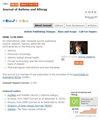Case Report: A Rare Case of Iodixanol-Induced Anaphylactic Shock in Cerebral Angiography
IF 3.7
3区 医学
Q2 ALLERGY
引用次数: 0
Abstract
Background: Adverse reactions induced by isoosmolar contrast medium (iodixanol) are mostly mild, with rashes and headaches being the most common. Although anaphylactic shock has been reported, no related incidents have been documented on cerebral angiography.Objective: This article reports a serious case of anaphylactic shock possibly induced by iodixanol and provides an overview of the case report.
Case Summary: A 65-year-old female with persistent headaches for nearly six months and CTA examination revealed multiple intracranial aneurysms. After two treatments, she returned to the hospital for aneurysm of reexamination a month ago. Following a preoperative assessment, cerebral angiography was performed. Three minutes after the procedure, the patient experienced dizziness, increased heart rate, followed by hypotension (BP 90/43 mm Hg), a sudden drop-in heart rate (HR 68 bpm), and a drop in SpO2 to 92%. Intravenous dexamethasone for anti-allergic were administered immediately, along with therapy through oxygen-inhalation. However, the patient then developed limb convulsions, unresponsiveness, and was urgently given diazepam for sedation and sputum aspiration to maintain airway patency. Blood pressure decrease to 53/29 mm Hg, and SpO2 readings were unavailable. Intravenous dopamine to elevates blood pressure, and assists breathing by intubating in the endotracheal. After 3 minutes, as the blood pressure remained undetectable, intermittent intravenous epinephrine 1mg was administered to raise the blood pressure, gradually restoring it to 126/90 mm Hg, and SpO2 increased to 95%. The patient was diagnosed with iodixanol-induced anaphylactic shock and urgently transferred to the NICU for monitoring and treatment. The patient died despite immediate treatment.
Conclusion: A 65-year-old female developed serious anaphylactic shock during cerebral angiography after receiving iodixanol. Although iodixanol is considered one of the safest iodinated contrast mediums (ICM), clinicians should be aware of its the potential for serious hypersensitivity reactions that can lead to fatal and life-threatening events.
病例报告:脑血管造影术中碘克沙醇诱发过敏性休克的罕见病例
背景:等渗造影剂(碘克沙醇)引起的不良反应大多较轻,最常见的是皮疹和头痛。虽然有过敏性休克的报道,但在脑血管造影术中还没有相关事件的记录:本文报告了一例可能由碘克沙醇诱发的过敏性休克的严重病例,并对病例报告进行了概述。病例摘要:一名 65 岁女性,持续头痛近半年,CTA 检查发现多发性颅内动脉瘤。经过两次治疗后,她于一个月前回到医院进行动脉瘤复查。术前评估后,进行了脑血管造影术。术后三分钟,患者出现头晕、心率加快,随后出现低血压(血压 90/43 mm Hg),心率突然下降(心率 68 bpm),SpO2 下降至 92%。医生立即静脉注射地塞米松抗过敏,并吸氧治疗。然而,患者随后出现四肢抽搐,反应迟钝,紧急给予地西泮镇静和吸痰,以保持呼吸道通畅。血压降至 53/29 mm Hg,无法获得 SpO2 读数。静脉注射多巴胺以升高血压,并通过气管插管辅助呼吸。3 分钟后,由于血压仍然检测不到,间断静脉注射肾上腺素 1 毫克以升高血压,血压逐渐恢复到 126/90 毫米汞柱,SpO2 升至 95%。患者被诊断为碘克沙醇诱发的过敏性休克,被紧急转入新生儿重症监护室进行监护和治疗。尽管立即进行了治疗,但患者仍然死亡:结论:一名 65 岁的女性在接受碘克沙醇治疗后,在脑血管造影过程中发生了严重的过敏性休克。尽管碘克沙醇被认为是最安全的碘化造影剂(ICM)之一,但临床医生仍应意识到它有可能导致严重的超敏反应,进而引发致命或危及生命的事件。
本文章由计算机程序翻译,如有差异,请以英文原文为准。
求助全文
约1分钟内获得全文
求助全文
来源期刊

Journal of Asthma and Allergy
Medicine-Immunology and Allergy
CiteScore
5.30
自引率
6.20%
发文量
185
审稿时长
16 weeks
期刊介绍:
An international, peer-reviewed journal publishing original research, reports, editorials and commentaries on the following topics: Asthma; Pulmonary physiology; Asthma related clinical health; Clinical immunology and the immunological basis of disease; Pharmacological interventions and new therapies.
Although the main focus of the journal will be to publish research and clinical results in humans, preclinical, animal and in vitro studies will be published where they shed light on disease processes and potential new therapies.
 求助内容:
求助内容: 应助结果提醒方式:
应助结果提醒方式:


